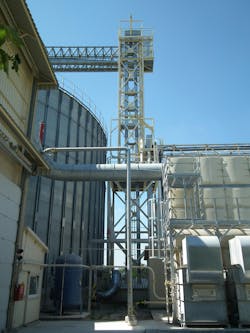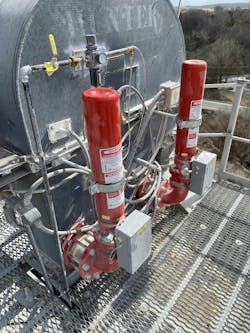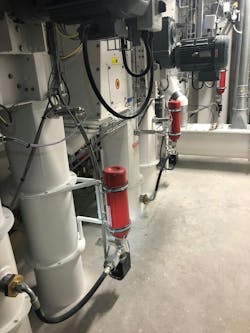Safeguarding against combustible dust explosions in bucket elevators

Bucket elevators are integral components in manufacturing processes across a spectrum of industries, from agriculture to mining and beyond. These machines are designed to vertically convey bulk materials, such as grains, pellets, chemicals, and aggregates, with efficiency and reliability. Consisting of a series of buckets attached to a rotating chain or belt, they convey materials from a lower level to a higher elevation, offering a cost-effective solution for vertical transportation within production facilities. As the buckets move along the vertical or inclined path, they pick up materials from an inlet at the bottom, or boot, of the elevator leg and then discharge the material at the top, or head, through a discharge chute or spout. The intermediate area between the boot and the head is the housing section. Bucket elevators can either be single leg, where the up leg and down leg are both in a single housing, or a double leg, where the up leg and down leg are in two separate housings with a common head and boot section.
A bucket elevator’s continuous process ensures a steady flow of materials, facilitating streamlined manufacturing operations. Many facilities handling materials that generate combustible dust rely on bucket elevators, including those that produce or process agricultural products, wood pellets, pet foods, and specialty chemicals. The bucket elevator’s versatility makes it indispensable in processes where the vertical movement of bulk materials is necessary.
Risks associated with bucket elevators
Although the bucket elevator is one of the most economical ways to vertically transport bulk materials, it has some drawbacks, such as the potential for material spillage, limited capacity compared to other conveyor systems, and the risk of mechanical breakdowns that can disrupt production. Additionally, during normal operation, bucket elevators inherently have the potential to create all five elements that are required to initiate a dust explosion: an ignition source, oxygen, fuel (dust), dispersion, and confinement. Due to this potential, bucket elevators should be operated with caution.
Hazards associated with bucket elevators primarily stem from their moving parts and the nature of the materials being transported. During operation, the buckets of the elevator impact material, creating fines and dust. These fine particles can become entrained in the air, generating enough fuel for a combustible dust explosion. Some of the most common ignition sources in bucket elevators are belt slips, belt misalignments, and hot bearings. Proper training, regular maintenance, and adherence to safety protocols are essential for mitigating these risks and ensuring a safe working environment in facilities utilizing bucket elevators.
Explosion prevention methods
If possible, it is better to take proactive measures to prevent an explosion from occurring than to try to mitigate the effects of an ignition event. It is common for ignition sources to come from equipment upstream of bucket elevators, such as mills or dryers. Temperature detection, spark detection, or infrared detection can be used to prevent these types of ignition sources from entering the bucket elevator’s inlet. These detectors can be programmed to either trigger an alarm or an automatic shutdown when they detect possible ignition sources.
Bucket elevators themselves also contain inherent sources of ignition due to the high kinetic energy from many moving metal parts. For the most common ignition sources within bucket elevators, both the U.S. Department of Labor’s Occupational Safety and Health Administration (OSHA) and the National Fire Protection Association (NFPA) have prescriptive requirements to prevent combustible dust explosions. OSHA sets and enforces federal workplace standards and has adopted various NFPA codes and standards regarding fire, explosion, and electrical safety in industrial settings.
Friction generated from a slipped belt or pulley on a conveyor can generate enough heat to act as an ignition source, so it is important to monitor the conveyor’s speed to prevent slippage. The speed monitoring device can be set up to automatically slow or stop the conveyor if the belt speed decreases beyond a setpoint. OSHA prescribes that the bucket elevator must be shut down when the belt speed is reduced by 20 percent or more of the normal operating speed (OSHA Standard 1910.272).
Misaligned belts can rub against other parts of the conveyor, generating enough heat and friction to ignite a dust cloud. If the misalignment is severe enough, buckets can scrape against the casing and generate sparks, which could be enough energy to ignite materials with higher minimum ignition energies (MIEs). A material’s MIE is the lowest energy required to ignite the material suspended in air. To prevent belt misalignment, sensors must be installed at the drive and tail ends of the bucket elevator to automatically trigger an alarm when the belt becomes misaligned and starts to rub. Both OSHA and NFPA require such misalignment sensors and automatic alarms.
Lastly, unlubricated bearings can also create enough friction and heat to ignite a suspended dust cloud. All critical bearings should include temperature sensors to ensure that they do not reach high enough temperatures to act as an ignition source. Both OSHA and NFPA require vibration or temperature monitoring for critical bearings.
Mitigating explosions in bucket elevators
Although preventative measures are required and it is best practice to include them to minimize possible ignition sources, explosion threats still exist within bucket elevators. Both passive and active strategies can be used to mitigate these risks, and each approach has advantages and limitations. Passive explosion mitigation measures do not require a detector or any sort of activation to properly mitigate the effects of an explosion. Examples include traditional deflagration vents, also known as explosion vents, and flameless vents. An active explosion mitigation solution requires some type of detection and activation to initiate the explosion mitigation equipment. Examples of active solutions include chemical suppression and chemical isolation.
Explosion venting
Traditional explosion venting is the most basic form of passive explosion protection equipment and serves as the backbone of explosion protection measures on bucket elevators. These systems are relatively straightforward, consisting of pressure relief panels installed on the bucket elevator housing. The spacing required between the vents is prescribed by either NFPA 61 or NFPA 68 and determined by the maximum reduced pressure (Pred) of the elevator and the dust’s deflagration index (Kst), which is the normalized rate of pressure rise of a given dust sample. During an explosion, these panels rupture, allowing the pressure and flame front to dissipate.
When considering explosion vents on a bucket elevator, the location of the elevator is critical. The bucket elevator must be outdoors to allow the pressure and flame to be safely relieved. It is also possible to duct the explosion vents outdoors if an interior elevator is located near an exterior wall. However, the length of this ducting has limitations. Explosion venting systems are effective in preventing catastrophic damage to internal equipment but can cause structural damage to the surrounding infrastructure, may require frequent maintenance due to the need for panel replacement after vent activations, and need to be directed toward normally unoccupied areas.
Flameless venting
When it is not possible to place the bucket elevator outdoors or if the bucket elevator cannot freely vent or be ducted to a safe area, flameless venting can be used. Flameless vents are designed to minimize the hazards associated with the expulsion of flames and hot gases. These systems quench the flame front and cool the vented gases. However, there are limitations to flameless venting technology, such as Kst and vessel (elevator) volume limitations that they can reliably protect.
Flameless vents are applied to an elevator in a similar fashion to explosion vents but may have a reduced venting efficiency due to the flame arrestor. Specially designed flameless vents for mechanical conveyors with a slimmer profile are available to maximize the provided vent area for bucket elevators. Flameless venting provides the ultimate passive solution for indoor elevator legs or portions of bucket elevators that may be at grade or in occupied areas.
Chemical suppression
As an active approach to explosion mitigation for bucket elevators, chemical suppression systems utilize detectors, controllers, and extinguishing agents to suppress and extinguish explosions in fractions of a second. Once an explosion is detected in its initial stages, a signal is relayed to the controller to activate the correct extinguishing bottles with a chemical suppressant. Suppressant is typically sodium bicarbonate, which quickly and uniformly injects into an elevator once activated. These systems can be activated using either pressure detectors or optical detectors, each offering different advantages.
Pressure detectors monitor changes in pressure within the elevator housing, activating the suppression system upon detecting a rapid pressure increase indicative of an explosion. While offering fast response times, pressure detectors can be accidentally activated from product buildup or clogging if the elevator is not properly designed and maintained.
Optical detectors employ sensors to detect the infrared and/or ultraviolet radiation associated with an explosion, triggering the chemical suppression system at an early stage in the deflagration development. Optical sensors have a quicker detection time and can activate a chemical suppression system more quickly than pressure sensors when utilized on a bucket elevator. A faster response results in the elevator experiencing a lower Pred during an explosion. This means that optical detectors can often be applied to create a more reliable and better performing suppression solution with fewer components for a bucket elevator.
A comprehensive approach
Selecting explosion protection for bucket elevators demands a comprehensive approach that considers the specific risks and requirements of each application. Both explosion prevention and mitigation solutions are required to safeguard against the hazards of combustible dust. While traditional explosion venting systems offer simplicity and reliability, advanced technologies such as flameless venting and chemical suppression systems provide enhanced safety features that allow bucket elevators to be protected anywhere in a facility.
Ultimately, the most suitable method of explosion protection for a bucket elevator depends on factors such as the nature of the materials handled, the operational environment, and budgetary considerations. By prioritizing robust explosion protection measures and turning to expert suppliers, processors can safeguard their operations and personnel against the inherent risks posed by bucket elevators.
Michael Laventure is a sales engineer at CV Technology, Jupiter, Florida.
CV Technology
www.cvtechnology.com
About the Author
Michael Laventure
Michael Laventure is a sales engineer at CV Technology, Jupiter, Florida.


